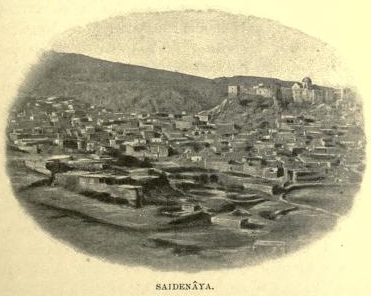|
Other Archaeological Sites / The Neolithic of the Levant (500 Page Book Online) Neolithic Saidnaya
Saidnaya's origins are in ancient times and the town has been inhabited since at least the sixth century BC when it was known by its Aramaic name Danaba. It emerged as an important center of Christianity well before Christianity was adopted as the official religion of the Roman empire. Macarius, the first bishop of Aleppo and later the Patriarch of Antioch, lists Saidnaya in a seventeenth-century Arabic manuscript as one of the seven ancient episcopal cities under Damascus, the same cities represented at the First Council of Nicaea in 325 AD (2).
(3) Five years in Damascus: including an account of the history topography and antiquities of that city : to serve the place of both beds and coverlets ; we were thus enabled to traverse with speed and ease the wide plateaus and mountain-ranges and to diverge from the more frequented roads whenever inclination might prompt us ... The road must unquestionably be of Roman origin and is one of those useful monuments with which that enterprising people filled every land that became subject to their sway. All the cities and all the more important villages in this country were at one time connected by well-constructed roads. ... We entered the fertile plain of Saidnaya. This plain is perfectly level and its soil is almost equal to that of the Ghutah. There is no water for irrigation ; but as it has a considerable elevation more rain falls upon it during winter and the heat of summer is not so excessive. ... We suddenly came in sight of the convent and village of Saidnaya—the former occupying the summit of a precipitous ledge of rock in the midst of a wide and rugged valley ; and the houses of the latter scattered along its base and clinging to its sides. The position and aspect of this building more nearly resemble those of a feudal castle of the middle ages than a peaceful retreat of piety and virtue. Saidnaya is the holiest shrine of the Virgin connected with the Greek church in Syria. The salubrity of the mountain air and the bracing exercise on the mountain-side often revive the enervated Damascene, who retires to this convent from the heat and filth of the city. In an Arabic manuscript in my possession entitled A History of the Seven Holy General Councils written near the beginning of the seventeenth century by Macarius, who was first bishop of Aleppo and afterwards patriarch of Antioch, are given the names of the ancient episcopal cities; and attached to most of them are their modern appellations. In this book I have found the name of Saidnaya recorded as one of the episcopal cities under Damascus, its ancient name being Danaba. The first mention of this place is found in Ptolemy who ranks it under the cities in the territory of Palmyra. The name also occurs in the Notitiae Ecclesiasticae as the seat of a bishop subject to the metropolitan of Damascus. No thing more however is known of its history. Selected Excerpt on Saidnaya The Neolithic of the Levant (1978) by A.M.T. Moore (Oxford University) There is one other site near Damascus at which traces of Neolithic 1 occupation has been found. This is Saidnaya which lies 23 kilometres north of the city in a valley on the eastern side of the Anti-Lebanon. The occupation deposit here lay near the surface and was quite thin. Most of the material belonged to a Mesolithic 2 flint industry but mixed with this were pieces which were typologically a little later. There were in particular three notched arrowheads; one had a straight retouched base and the other two were tanged. These arrowheads can be paralleled at both Tell Aswad I and Mureybat III --- indicating that Saidnaya was occupied briefly at this time. Saidnaya is thus the second site known in the Anti-Lebanon with Neolithic 1 occupation.
(1) An account of Palmyra and Zenobia etcetera by William Wright (1895)
(2) Saidnaya in Wikipedia
(3) Five years in Damascus: including an account of the history topography and antiquities of that city :
|

